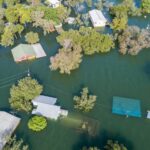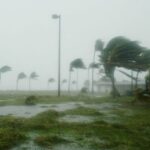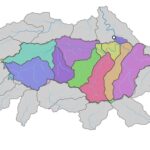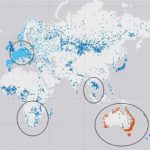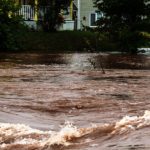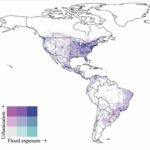For the first time, researchers from Utrecht University including Fathom’s Dr Jannis Hoch have applied the global hydrological model (GHM) PCR-GLOBWB at 1 km spatial resolution over the entire European continent.
GHMs are typically used for consistent global analyses of water availability such as flood risk (WRI Aqueduct Water Risk Atlas) or water shortage (National Geographic World Water Map). With climate change already impacting the water cycle, GHMs could become increasingly important in risk management. However, GHMs are currently applied at relatively coarse resolution (~100 km2), which conceals much of the local detail needed for local water availability assessments.
Enabling GHM to run at 1 km spatial resolution is therefore paramount for studies applied everywhere and at locally relevant scales. While hydrologists have been discussing hyper-resolution GHMs for almost a decade, data availability, computational demand and storage requirements were limiting factors to put the idea into practice. With this publication, the researchers overcame most of these problems and aimed to contribute to the next development cycle of GHMs.
What is PCR-GLOBWB?
PCR-GLOBWB (PCRaster Global Water Balance) is a hydrological and water resources model developed by the University of Utrecht over the past two decades. It is used on global and regional scales to quantify and understand the terrestrial water cycle. By including domestic and industrial water demand and use, the impact of human interference with the water cycle can be quantified.
The research: The first hyper-resolution model
The main objective of this study was to not only apply the model, but also to map needed improvements with respect to the currently used coarser resolutions.
To that end, different model set-ups with various spatial resolutions were evaluated against available observations. Outcomes of the evaluation were then compared across model set-ups to determine the strengths and weaknesses of this first hyper-resolution model.
The results: A step closer to meeting the ‘grand challenge’
The results confirmed that improvements are needed: while streamflow estimates improved over coarser models, other important hydrological parameters such as soil moisture and evaporation, do not. Despite these first gains and promising streamflow results, there is still a lot of work to do, as the uncertainty in model outputs and analysis are still large.
Unravelling the causes for the mixed results and improving model certainty are now the most important tasks at hand. A first attempt has already been made to scale up the model application from the continental to the global scale to test possible ways forward. But many more experiments are needed to meet this “grand challenge” of a consistent hydrological model applicable at all scales, from local to global.
Read the research paper in full from Hydrology and Earth System Sciences
Further reading
Research and datasets by Fathomers can be found in the list of references for this research paper. Helping support scientific advancement is one of the key reasons we prioritize the development of new research, which is published in open and leading academic journals.
Research includes:
The CAMELS data set: catchment attributes and meteorology for large-sample studies
LISFLOOD-FP 8.0: the new discontinuous Galerkin shallow-water solver for multi-core CPUs and GPUs
PCR-GLOBWB 2: a 5 arcmin global hydrological and water resources model


